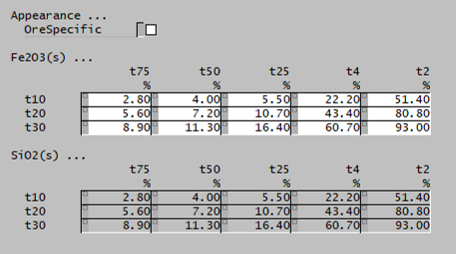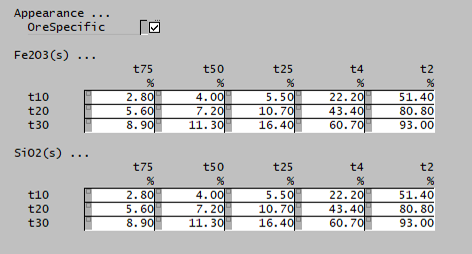Impact Crusher (Kojovic)
Description
This article describes an implementation of the Kojovic impact crusher model outlined by Kojovic et al. (1997).[1][2]
The model is useful for simulating the product particle size distribution from vertical and horizontal shaft impact crushers, and similar equipment.
Model theory
Vertical shaft impact crusher
Horizontal shaft impact crusher
Power draw
Multicomponent modelling
Excel
The Kojovic impact crusher model may be invoked from the Excel formula bar with the following function call:
=mdUnit_ImpactCrusher_Kojovic(Parameters as Range, Size as Range, CrusherFeed as Range, Appearance as Range, Ab as Range)
Invoking the function with no arguments will print Help text associated with the model, including a link to this page.
Inputs
The required inputs are defined below in matrix notation with elements corresponding to cells in Excel row () x column () format:
where:
- is an optional input that determines the internal mesh series used by the model (0 = mesh, 1 = External mesh, 2 = External + mesh). If omitted, the default mesh is used.
- is the number of size intervals
- is the number of ore types
- is the size of the square mesh interval that mass is retained on (mm)
- , i.e. descending size order from top size () to sub mesh ( mm)
- is the mass flow rate of particles in the crusher feed (t/h)
- is the fraction of mass passing one-th the size of a parent particle (%) when passes one-tenth the size of a parent particle (%), ,
- and are the ore-specific drop weight test comminution hardness parameters (% and t/kWh, respectively).
Results
The results are displayed in Excel as an array corresponding to the matrix notation below:
where is the mass flow rate of particles in the crusher product (t/h).
Example
The images below show the selection of input arrays and output results in the Excel interface.
SysCAD
The sections and variable names used in the SysCAD interface are described in detail in the following tables.
MD_Crusher page
The first tab page in the access window will have this name.
| Tag (Long/Short) | Input / Display | Description/Calculated Variables/Options |
|---|---|---|
| Tag | Display | This name tag may be modified with the change tag option. |
| Condition | Display | OK if no errors/warnings, otherwise lists errors/warnings. |
| ConditionCount | Display | The current number of errors/warnings. If condition is OK, returns 0. |
| GeneralDescription / GenDesc | Display | This is an automatically generated description for the unit. If the user has entered text in the 'EqpDesc' field on the Info tab (see below), this will be displayed here.
If this field is blank, then SysCAD will display the unit class ID. |
| Requirements | ||
| On | CheckBox | This enables the unit. If this box is not checked, then the material will pass straight through the crusher with no change to the size distribution. |
| NumParallelUnits | Input | The number of parallel, identical units to simulate:
|
| Method | Fixed Discharge | The discharge particle size distribution is user defined. Different distributions can be used for different solids. |
| Whiten | The product size distribution and power draw are determined by the Whiten crusher model. Different parameters can be used for different solids. | |
| Impact (Kojovic) | The product size distribution and power draw are determined by the Kojovic impact crusher model. Different parameters can be used for different solids. | |
| Options | ||
| ShowQFeed | CheckBox | QFeed and associated tab pages (eg Sp) will become visible, showing the properties of the combined feed stream. |
| ShowQProd | CheckBox | QProd and associated tab pages (eg Sp) will become visible, showing the properties of the products. |
| SizeForPassingFracCalc | Input | Size fraction for % Passing calculation. The size fraction input here will be shown in the Stream Summary section. |
| FracForPassingSizeCalc | Input | Fraction passing for Size calculation. The fraction input here will be shown in the Stream Summary section. |
| Stream Summary | ||
| MassFlow / Qm | Display | The total mass flow in each stream. |
| SolidMassFlow / SQm | Display | The Solids mass flow in each stream. |
| LiquidMassFlow / LQm | Display | The Liquid mass flow in each stream. |
| VolFlow / Qv | Display | The total Volume flow in each stream. |
| Temperature / T | Display | The Temperature of each stream. |
| Density / Rho | Display | The Density of each stream. |
| SolidFrac / Sf | Display | The Solid Fraction in each stream. |
| LiquidFrac / Lf | Display | The Liquid Fraction in each stream. |
| Passing | Display | The mass fraction passing the user-specified size (in the field SizeForPassingFracCalc) in each stream. |
| Passes | Display | The user-specified (in the field FracForPassesSizeCalc) fraction of material in each stream will pass this size fraction. |
Crusher page
The Crusher page is used to specify the input parameters for the crusher model.
Ore page
This page is used to define the crusher comminution properties of SysCAD species with the size distribution quality in the project.
About page
This page is provides product and licensing information about the Met Dynamics Models SysCAD Add-On.
| Tag (Long/Short) | Input / Display | Description/Calculated Variables/Options |
|---|---|---|
| About | ||
| HelpLink | Opens a link to the Installation and Licensing page using the system default web browser. Note: Internet access is required. | |
| Information | Copies Product and License information to the Windows clipboard. | |
| Product | ||
| Name | Display | Met Dynamics software product name |
| Version | Display | Met Dynamics software product version number. |
| BuildDate | Display | Build date and time of the Met Dynamics Models SysCAD Add-On. |
| License | ||
| File | This is used to locate a Met Dynamics software license file. | |
| Location | Display | Type of Met Dynamics software license or file name and path of license file. |
| SiteCode | Display | Unique machine identifier for license authorisation. |
| ReqdAuth | Display | Authorisation level required, MD-SysCAD Full or MD-SysCAD Runtime. |
| Status | Display | License status, LICENSE_OK indicates a valid license, other messages report licensing errors. |
| IssuedTo | Display | Only visible if Met Dynamics license file is used. Name of organisation/seat the license is authorised to. |
| ExpiryDate | Display | Only visible if Met Dynamics license file is used. License expiry date. |
| DaysLeft | Display | Only visible if Met Dynamics license file is used. Days left before the license expires. |
See also
References
- ↑ Kojovic, T., Napier-Munn, Timothy J., and Andersen, J. S. (1997). Modelling cone and impact crushers using laboratory determined energy-breakage functions. Comminution Practices Symposium: SME Annual Meeting 1997, Denver, CO, USA, 24-27 February, 1997. Littleton, CO, USA: Society for Mining, Metallurgy and Exploration.
- ↑ Napier-Munn, T.J., Morrell, S., Morrison, R.D. and Kojovic, T., 1996. Mineral comminution circuits: their operation and optimisation. Julius Kruttschnitt Mineral Research Centre, Indooroopilly, QLD.































